Design and Application of Project Energy Management System of Beijing Foreign Affairs University
Abstract: With the continuous deepening of enterprise reform, the modernization level of power supply management is increasingly demanding, and it can quickly and accurately obtain the power data of each power link, electricity consumption analysis, load management, operation monitoring, and electricity charges. Automatic settlement, a powerful tool to improve the economic efficiency of enterprises. In order to improve the monitoring system, technical personnel have gradually increased their research work on the monitoring system in recent years, and they have begun to use new technologies to reconstruct the existing monitoring system, which has provided great help for the optimization of monitoring systems in various departments. . A brief introduction to the user-side energy use intelligence is given in the ACREL-3000 energy management system used in the Beijing Foreign Affairs Academy project.
Keywords: Beijing Foreign Affairs University; Acrel-3000 type; power management system;
0, Overview
This project is Beijing Foreign Affairs University Project Beijing Foreign Affairs University's power management system. According to the requirements of power management, it is necessary to monitor and control the power input of Beijing Foreign Affairs University to achieve safe use of electricity, resource conservation and environmental protection, and to achieve the target of “safety use of electricity, economical use of electricity, orderly use of electricity, and intelligent use of electricityâ€. .
The Acrel-3000 power management system takes full advantage of the latest developments in modern electronic technology, computer technology, network technology, and fieldbus technology to conduct distributed data collection and centralized monitoring and management of distribution systems. The secondary equipment of the distribution system is networked, and the distributed power meter of the distribution cabinet is connected as an organic whole through the computer and communication network to realize the remote monitoring and centralized management of each power supply circuit.
1, system structure description
The monitoring system mainly implements electricity monitoring for the project's distribution system of the Beijing Foreign Affairs University; the monitoring scope is for two campuses including teaching buildings, office buildings, student dormitories, libraries, canteens and other 15 low-voltage meters. The system has a total of 470 instruments, divided into 15 collection areas and 42 buses, which are respectively collected and finally passed through the campus LAN to the monitoring host of the communication room to achieve data collection and management.
The monitoring system adopts a hierarchical distributed structure, namely station control layer, communication layer and equipment layer; as shown in Figure (1):
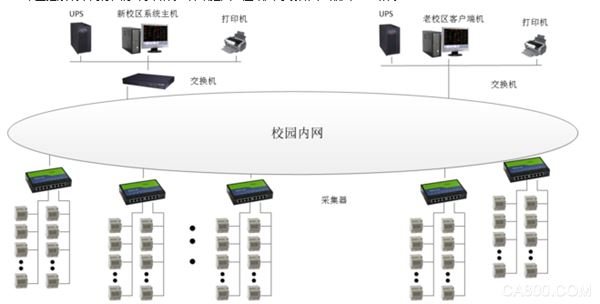
Figure (1) Network topology
The main equipment layer is: Multi-functional network power meters. These devices are corresponding to the corresponding primary equipment installed in the electrical cabinet, these devices are used RS485 communication interface, through the on-site MODBUS bus network communication, data acquisition on the spot.
The main network communication layer is: serial port conversion isolator. Its main function is to collect the scattered data at the site collection device, and transmit it to the station control layer at the same time to complete the data exchange between the field layer and the station control layer.
Station control management: equipped with high-performance industrial computers, monitors, UPS power supplies, printers and other equipment. The monitoring system is installed on the computer to collect and display the operating status of the field equipment and display it to the user in the form of human-computer interaction.
The above network instruments all use RS485 interface and MODBUS-RTU communication protocol. RS485 adopts shielded wire transmission. Generally, two wires are used for connection. The connection is simple and convenient. The communication interface is half-duplex communication. Both parties can receive and send data. Only data can be sent or received at the same time. The maximum data transmission rate is 10Mbps. The RS485 interface uses a combination of balanced drivers and differential receivers to enhance noise immunity.
2. Main functions of the power management system
2.1 Data Acquisition and Processing
Data acquisition is the basis of power distribution monitoring. Data collection is mainly accomplished by the underlying multi-function network instrumentation, realizing local real-time display of remote data. The signals that need to be collected include: three-phase voltage U, three-phase current I, frequency Hz, power P, power factor COS φ, power Epi, and communication device operation status.
The data processing mainly displays the electrical parameters collected according to requirements in real time and accurately to the user, so as to meet the requirements of automation and intelligence of the power distribution monitoring, and store the collected data in the database for user query.
2.2 Human-computer interaction
The system provides simple, easy to use, and good user interface. Using the Chinese interface, the CAD graphic shows the electrical main wiring diagram of the low voltage distribution system, shows the status of the distribution system equipment and the corresponding real-time operating parameters, the screen timing switching tour; dynamic refresh of the screen real-time; analog display; switch display; continuous Record display and so on.
2.3 Historical events
The historical event viewing interface provides convenient and friendly human-computer interaction for the user to view fault records, signal records, operation records, and over-limit records that have occurred. You can view the platform through historical events. You can easily locate your own according to your requirements and query conditions. The historical events that you want to view provide you with good software support for the overall system operation.
2.4 Database Establishment and Query
It mainly completes the remote measurement and remote signal acquisition, and establishes a database to generate reports regularly for users to query and print.
2.5 User Rights Management
For different levels of users, different permission groups are set to prevent the losses caused by human misoperation to production and life, and to realize the safe and reliable operation of the distribution system. You can use user management to perform user login, user logout, password change, and add/delete operations to facilitate user modification of accounts and permissions.
2.6 Running load curve
The load trend curve function is mainly responsible for regularly collecting incoming lines and important loop current and power load parameters, and automatically generating running load trend curves to facilitate users to know the operating load status of the equipment in a timely manner. Click the corresponding button or menu item of the screen to complete the switching of the corresponding function; you can view the real-time trend curve or historical trend line; you can perform translation, zoom, range conversion and other operations on the selected curve to help the user to enter the trend analysis and fault recall. Analyzing the entire system's operating status provides intuitive and convenient software support.
2.7 Remote Report Query
The main function of the report management program is to design the report style according to the needs of the user, and the data processed in the system is filtered, combined and statistically generated to generate the report data required by the user. This program can also be based on the needs of users on the report file to save, print. At the same time, this program also provides users with management functions for generated report files.
The report has the functions of freely setting the query time to realize daily, monthly, and annual energy statistics, data export, and report printing.
3, case analysis
The project of the Beijing Foreign Affairs University consists of 15 buildings. This project implements electric energy monitoring and management for the distribution systems of the 15 buildings.
The input and output circuit of the distribution cabinet adopts a multi-function instrument and is a network power meter designed for the power monitoring needs of power systems, industrial and mining enterprises, public facilities, and intelligent buildings. It can measure conventional power parameters such as three-phase voltage, current, and Active power, reactive power, power factor, frequency, active power, reactive power and other electrical parameters. The series of network power meters are mainly used in substation automation, distribution network automation, residential power monitoring, industrial automation, energy management systems and intelligent buildings.
Low-voltage power distribution diagram shown in Figure (2), the function of the main telemetry power monitoring equipment operating parameters, including: line three-phase voltage, current, power, power factor, electrical energy, frequency and other electrical parameters and distribution loop three Phase current; Remote signal function Realize the running status of the display field equipment, mainly including: switch's dividing, closing running status and communication failure alarm; When the circuit breaker is dislocated, it will send an alarm signal to remind the user to handle the fault in time.
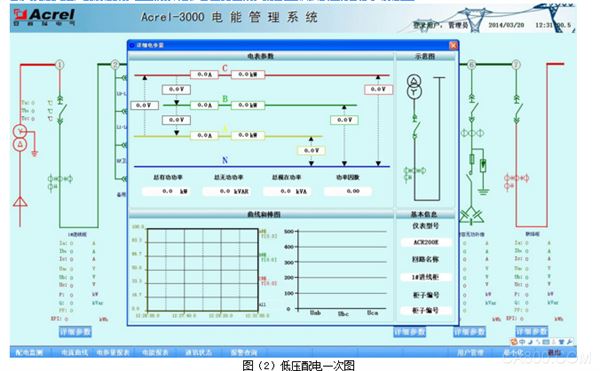
The remote signaling and telemetry alarm functions mainly complete the monitoring of the switching operation status of the low-voltage outlet circuits and the incoming line monitoring of the load. The pop-up alarm interface is displayed for switch displacement and load over-limit, indicating the specific alarm position and sound alarm to remind the on-duty personnel to deal with it in time. With real-time query function, see Figure (3).
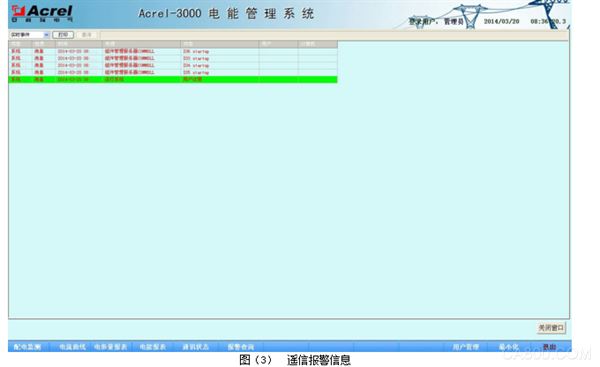
The parameter reading function mainly inquires into the electrical parameters of the low-voltage outlet circuit. Supports electrical parameter query at any time, with functions such as data export and report printing. The report queries the electrical parameters of the low-voltage loop and mainly includes: three-phase voltage, current, power factor, active power, and active power. The names of the loops in this report are associated with the database to facilitate the user to modify the loop name. See Figure (4).
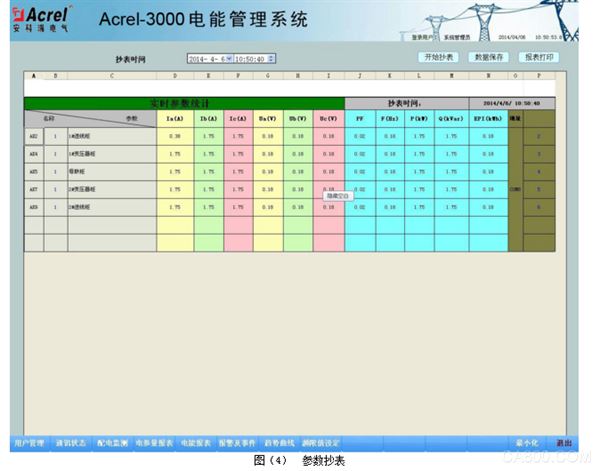
The electricity consumption report function can select the time period to inquire, supports the accumulated electricity inquiry at any time, and has the functions of data export and report printing. Provide accurate and reliable power report for duty personnel. The names of the loops in this report are associated with the database to facilitate the user to modify the loop name. As shown in the figure below, the precise power consumption of each distribution circuit in a certain period of time can be displayed. The user can directly print the report and can save it in EXCEL format to another location. See Figure (5).
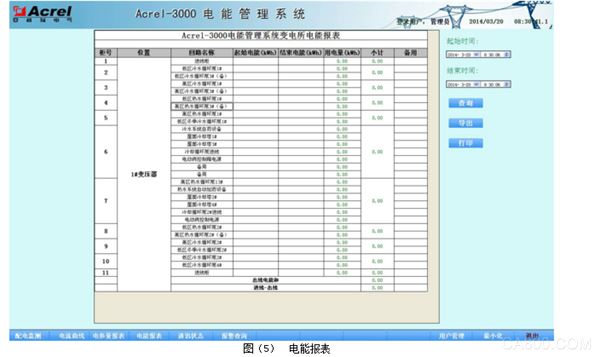
The load trend curve interface allows you to visually check the load operation of the loop. View real-time and historical trend curves, click the corresponding button or menu item of the screen to complete the switching of corresponding functions; help the user to perform trend analysis and fault recall, with curve printing function. Provides intuitive and convenient software support for analyzing the health of the entire system. See Figure (6).

The schematic diagram of the system communication structure mainly shows the networking structure of the system. The system adopts a hierarchical distributed structure and simultaneously monitors the communication status of the equipment at the bay level. Red indicates normal communication and green indicates communication failure. See Figure (7).
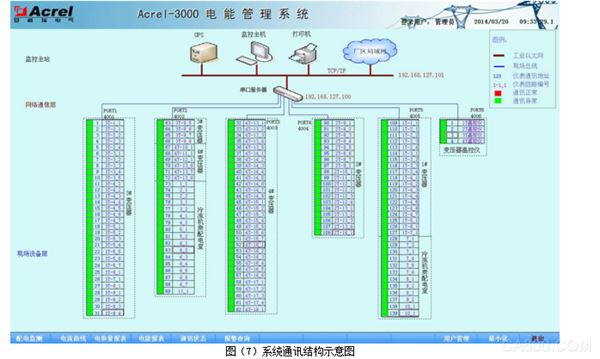
4 Conclusion
With the development of society and the wide application of electricity, the power management system has become an inevitable choice for large-scale multi-substation users, such as key projects, landmark buildings, and large-scale public facilities throughout the country. The Acrel-3000 energy management system introduced in this paper is introduced. The application of the project at the Beijing Foreign Affairs University can realize real-time monitoring and power management of power distribution and low-voltage distribution circuits. It can not only show the power status of the circuit, but also has network communication functions. It can be combined with serial servers and computers to form power management. system. The system analyzes and processes the collected data, displays the operating status of each distribution circuit in the substation in real time, and generates various energy reports, analysis curves, and graphs, which facilitates remote meter reading and analysis and research of electric energy. The system is safe, reliable and stable. It provides real and reliable basis for users of substations to solve electricity problems and has achieved good social benefits. [2]
About the author: He Meifang, female, Ankerui Electric Co., Ltd., the main research direction for the smart grid power distribution, Email: Contact: 021-69156950 QQ
The RIMA LFP series lithium battery is made of LiFePO4 cells, the battery has been designed and developed to provide a lighter, higher power and longer life solution to lead acid batteries. LiFePO4 batteries last longer and can produce 10 times the number of cycles than a typical lead acid battery. At only 40% of the weight of the equivalent lead acid battery, our LiFePO4 range is ideal for those applications that need to be lighter and more mobile but deliver the same power.
OREMA POWER CO., LTD. , https://www.oremabattery.com
